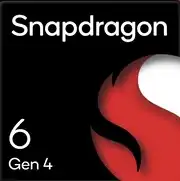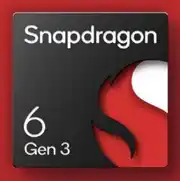Qualcomm Snapdragon 6 Gen 4

Snapdragon 6 Gen 4: a balanced 4 nm mid-range SoC
Snapdragon 6 Gen 4 is an update to the popular “6-series” with a focus on power efficiency and higher CPU/GPU throughput. The move to modern Arm v9 cores and a faster graphics pipeline makes the platform noticeably stronger than its predecessor while keeping power draw in check.
What’s inside
-
CPU: 8 cores — 1× Cortex-A720 up to 2.3 GHz, 3× Cortex-A720 up to 2.2 GHz, and 4× Cortex-A520 up to 1.8 GHz.
-
GPU: Adreno 810 — reliable FHD+ gaming with support for high refresh rates.
-
Memory & storage: LPDDR5/LPDDR4X and UFS 3.1 — quick app launches and steady performance under heavy workloads.
-
Displays & video: FHD+ up to 144 Hz, external displays up to 4K60 HDR over USB-C; game features like upscaling and frame interpolation.
-
Connectivity & audio: 5G, Wi-Fi 6/6E, Bluetooth 5.4, enhanced audio stack with high-quality codecs.
-
AI features: updated Sensing Hub and more efficient low-precision modes (including INT4) for on-device models.
What’s improved vs. Snapdragon 6 Gen 3
-
CPU architecture: switches from Cortex-A78/A55 (Arm v8) to Cortex-A720/A520 (Arm v9), bringing higher IPC and better efficiency at similar load levels.
-
Graphics: from Adreno 710 to Adreno 810 — higher rendering throughput, steadier sustained clocks, broader game tech support.
-
Displays: support for higher refresh (up to 144 Hz) versus the prior generation’s typical 120 Hz — helpful for UI fluidity and gaming.
-
Connectivity: Bluetooth 5.4 (versus 5.2 previously) for more flexible low-power profiles and modern accessories.
-
AI & imaging: retains the “headline” camera (up to 200 MP) and video (4K@30) capabilities while improving HDR/noise reduction and speeding up lightweight on-device models.
How it stacks up against rivals
-
MediaTek Dimensity 7xx (7200/7300, etc.): broadly similar CPU class and efficiency; 6 Gen 4 often benefits from a mature Adreno graphics stack and driver support for popular engines, plus the newer Bluetooth 5.4.
-
Mid-range Exynos: strong modem/ISP packages, but sustained FHD+ frame-rate stability is frequently comparable to—or behind—same-class Adreno solutions.
-
Bottom line: 6 Gen 4 is among the most balanced mid-range options, with no glaring bottlenecks and a solid CPU/GPU/connectivity/camera mix.
Performance
-
AnTuTu v10: roughly ~700–780K
-
Geekbench 6: around ~1100 (Single) and ~3100 (Multi)
Gaming and everyday use
Adreno 810 runs popular online titles comfortably on medium/high presets at FHD+. In daily use you get quick UI response, stable multitasking, and predictable battery life thanks to the 4 nm process and more efficient CPU cores.
Devices on Snapdragon 6 Gen 4
-
realme 14 5G (2025)
-
OPPO K13 5G (2025)
-
HONOR X70 (2025)
Verdict
A well-balanced mid-range platform: modern CPU architecture (A720/A520), a clearly faster GPU, up-to-date connectivity (5G, Wi-Fi 6/6E, Bluetooth 5.4), and expanded multimedia (FHD+ 144 Hz, external 4K60 HDR). Not a flagship, but a robust and current foundation for a stable everyday experience.
Basic
3x 2.2 GHz – Kryo Gold (Cortex-A720)
4x 1.8 GHz – Kryo Silver (Cortex-A520)
GPU Specifications
Connectivity
Memory Specifications
Miscellaneous
- AIFF
- CAF
- MP3
- MP4
- WAV
- H.265
- VP9
Benchmarks
Phones with Snapdragon 6 Gen 4


Comparison of Devices with Snapdragon 6 Gen 4
Compared to Other SoC
Related SoC Comparisons
Share in social media
Or Link To Us
<a href="https://cputronic.com/soc/qualcomm-snapdragon-6-gen-4" target="_blank">Qualcomm Snapdragon 6 Gen 4</a>


